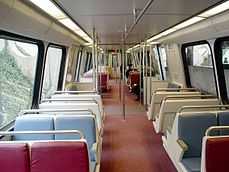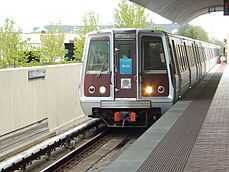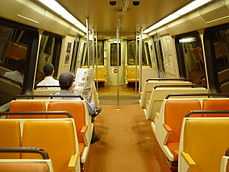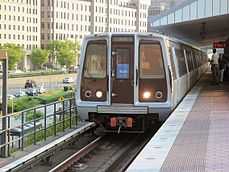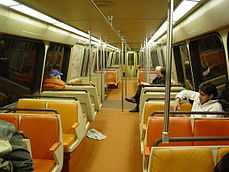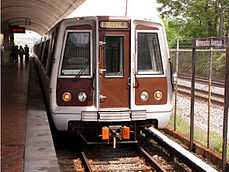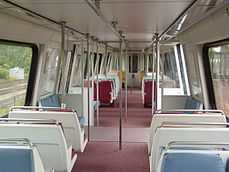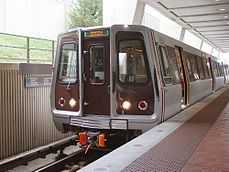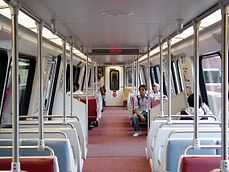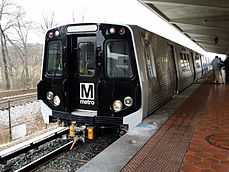Washington Metro rolling stock
The rolling stock of the Washington Metro system consists of 1,130[1] 75-foot (22.86 m) cars, delivered in six shipments. All rail cars in the Metrorail system operate in married pairs (consecutively numbered even-odd), with systems shared across the pair. The system rail gauge is a modified, or near, standard gauge 4 ft 8 1⁄4 in (1,429 mm), 0.25 inches (6.4 mm) closer than standard gauge.[2] The platform height is said to be 38.5 inches (980 mm) above top of rail (ATR) and rolling stock floor height is also 381⁄2 ± 3⁄4 in (978 ± 19 mm) ATR for level entry. The Washington Metro’s floors and platforms are lower than those of most other East Coast mass transit systems, such as in New York City, Boston, and Philadelphia.
The number of revenue cars is expected to remain constant until early 2015, when the first of the 7000 series cars start passenger service.[3]
1000-series
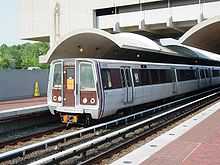
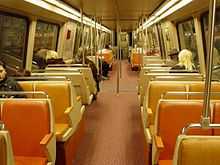
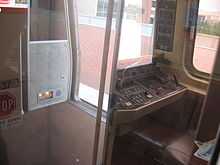
The original order of 300 Metro cars was manufactured by Rohr Industries, with delivery in 1976. These cars are numbered 1000–1299, and were rehabilitated in the mid-1990s by Breda Costruzioni Ferroviarie (now AnsaldoBreda) and WMATA at their Brentwood Shop in northeast Washington, D.C.
There are two major characteristics that distinguish the 1000-series from the later series cars. On their sides, the cars had two mylar curtain rollsigns, one above a window next to the doors on each end, while the other car classes have a single flip-dot or LED sign above a window next to the center doors. Second, the bulkheads on each end of the 1000-series cars feature windows that extend to the top of the bulkhead frame, whereas other car classes' bulkhead windows only extend slightly higher than the side windows.
The 1993 rehabilitation converted one rollsign on each side into an exterior loudspeaker while the other rollsign, as well as the bulkhead signs, were converted to flip-dot displays, replacing the original rollsigns. The cars also received AC propulsion, replacing the cam-controlled DC propulsion systems, making them the first cars on the system to use such propulsion.
The original interiors have a white grained appearance with 82 orange and brown seats. Future orders would have seating reduced down to 64 or 68, as seats next to the doors would be removed for additional standing areas.
Of these original 300 cars, 290 remain in active revenue service. Car 1028, separated from its mate after it was destroyed during the Federal Triangle derailment in 1982, has become the feeler car that checks system clearances . Cars 1114-1115 are used only in work service. Four cars 8000–8003, serve as the money train to collect the revenue from station fare card machines These are former passenger cars 1010+1011 and 1044+1045. 1076 is also permanently out of service after its mate was destroyed in the 2004 accident at Woodley Park station.[4] 1079[5] was the lead car on the second train involved in the June 22, 2009 Washington Metro train collision.[6]
As of August 2008, Metrorail was testing new overhead handles of different styles on 1122, 1123, 1126, 1127, as well as some 3000-series cars to gauge public opinion.[7]
Following the June 22, 2009 collision, Metro implemented a policy of no longer placing 1000-Series rail car pairs at the ends of train consists in order to prevent telescoping in a collision, as they are the weakest rolling stock structurally.[8] The new policy places 1000-Series cars in the center of six and eight-car consists, with rail cars of other series in the end positions.
These cars, and the 4000 series, are expected to be retired by the 7000 series between 2015 and 2017.[9]
- Car Builder: Rohr Industries, Winder, Georgia, USA
- Dates Built: 1973–1976
- Rehabilitated: 1993–1996
- Rehabilitated by: WMATA Brentwood Shop/Breda Costruzioni Ferroviarie (now AnsaldoBreda), Washington, DC, USA
- Car Body: Extruded Aluminum
- Car Numbers: 1000–1299
- Car Length: 75 feet (22.86 m)
- Car Width: 10 feet (3.05 m)
- Car Height: 11.8 feet (3.60 m)
- Track Gauge: 4 ft 8 1⁄4 in (1,429 mm)
- Truck Type: Cast Steel
- Maximum Operating Speed: 75 mph (121 km/h)
- Propulsion System: Four General Electric "5GEB" 3 Phase, 4 pole, Asynchronous AC Traction Drives with GTO Inverters (post rehab)[10]
- Power Output (Per Motor): 186.5 kilowatts (250.1 horsepower)[10]
- Power Output (Per Car): 746 kilowatts (1,000 horsepower)
- Braking System: Abex Hydraulics
- Seating capacity: 82
- Total Capacity: 175
2000-series
| Washington Metro 2000 series | |
|---|---|
|
A train of 2000-series Breda cars at Huntington following rehabilitation. | |
|
Interior of Breda 2075 following rehabilitation. | |
| Manufacturer | Breda Costruzioni Ferroviarie (now AnsaldoBreda) |
| Order number | 76 |
| Built at | Pistoia, Italy |
| Constructed | 1981–1983 |
| Refurbishment | 2002–2004 |
| Number built | 76 |
| Number in service | 76 |
| Fleet numbers | 2000–2075 |
| Capacity |
Seating: 68 Total: 175 |
| Operator | Washington Metropolitan Area Transit Authority |
| Specifications | |
| Car body construction | Extruded Aluminum |
| Train length | 300 feet (91.44 m) |
| Car length | 75 feet (22.86 m) |
| Width | 10 feet (3.05 m) |
| Height | 11.8 feet (3.60 m) |
| Floor height | 1,000 mm (39.37 in) |
| Doors | Sliding, 6 per car |
| Maximum speed | 75 miles per hour (121 km/h) |
| Traction system | Four Alstom ONIX 2000 AC Traction Drives with IGBT Inverters (post rehab)[11] |
| Power output |
165 kilowatts (221 horsepower) per motor 600 kilowatts (800 horsepower) per car |
| Electric system(s) | 750 DC third rail |
| Current collection method | Contact shoe |
The second order, of 76 cars, was through Breda Costruzioni Ferroviarie (now AnsaldoBreda), with delivery in 1982.
These cars are numbered 2000–2075, and were rehabilitated in 2003 and 2004 by Alstom in Hornell, New York. The cars, as part of a rehabilitation project, have received new AC propulsion systems with IGBT technology, replacing the original cam-controlled DC propulsion systems. Also included were railcar monitoring systems, advanced ATC/ATS control systems, exterior LED destination signs, interior LED next stop signs, and improved emergency exit signage.
The refurbished railcars also received the red, white, and blue interior found on the 5000-series cars.
3000-series
| Washington Metro 3000 series | |
|---|---|
|
A train of Breda 3000-series cars prior to rehabilitation arrives at Van Dorn Street station. | |
|
Interior of Breda 3267 prior to rehabilitation. | |
| Manufacturer | Breda Costruzioni Ferroviarie (now AnsaldoBreda) |
| Order number | 290 |
| Built at | Pistoia, Italy |
| Constructed | 1984–1988 |
| Refurbishment | 2004–2009 |
| Number built | 290 |
| Number in service | 290 |
| Fleet numbers | 3000–3289 |
| Capacity |
Seating: 68 Total: 175 |
| Operator | Washington Metropolitan Area Transit Authority |
| Specifications | |
| Car body construction | Extruded Aluminum |
| Train length | 300 feet (91.44 m) |
| Car length | 75 feet (22.86 m) |
| Width | 10 feet (3.05 m) |
| Height | 11.8 feet (3.60 m) |
| Floor height | 1,000 mm (39.37 in) |
| Doors | Sliding, 6 per car |
| Maximum speed | 75 miles per hour (121 km/h) |
| Traction system | Four Alstom ONIX 2000 AC Traction Drives with IGBT Inverters (post rehab)[11] |
| Power output |
165 kilowatts (221 horsepower) per motor 600 kilowatts (800 horsepower) per car |
| Electric system(s) | 750 DC third rail |
| Current collection method | Contact shoe |
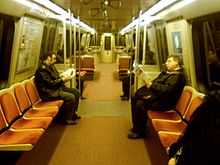
The third order consisted of 290 cars, also from Breda, with delivery in 1987.
These cars are numbered 3000–3289 as delivered, and were rehabilitated by Alstom in Hornell, New York. As part of this rehabilitation project, they received AC propulsion systems with IGBT technology, replacing the chopper-controlled DC propulsion system. Also included in the rehabilitation is the addition of railcar monitoring systems, advanced ATC/ATS control systems, exterior LED destination signs, interior LED next stop signs, and improved emergency exit signage. The refurbished 3000-series cars also received the red, white, and blue interior found on the 5000-series cars.
On January 6, 1996, a revenue train collided with an out-of-service train, both consisting entirely of Breda 3000-series cars, at the Shady Grove station, fatally injuring the operator of the revenue train. 3252, the lead car of the revenue train, collided with 3191, the car at the inbound end of the out-of-service train.[12] The mates of these two cars, 3253 and 3190 respectively, were later mated together. 3190 reentered revenue service as 3290, and 3253 reentered service as 3291.
Beginning in 2005, a number of 3000-series cars that had not yet undergone rehabilitation were modified as part of a pilot program to study passenger movements to improve the seating arrangement for future rail cars. Sixteen cars received a new seating arrangement that included modified handholds and seat positions, including some longitudinal seating. These cars, as well as other cars being used as control cars in the experiment, received on-board cameras in order for planners to observe passenger movements.[13][14][15][16]
As of August 2008, Metrorail is testing new overhead handles of different styles on 3034, 3035, 3094, 3095 as well as some 1000-series cars to gauge public opinion.[7]
4000-series
| Washington Metro 4000 series | |
|---|---|
|
A Blue Line train of Breda 4000-series cars arrives at King Street – Old Town station. | |
|
Interior of Breda 4018. | |
| Manufacturer | Breda Costruzioni Ferroviarie (now AnsaldoBreda)[17] |
| Order number | 100 |
| Built at | Pistoia, Italy |
| Constructed | 1991–1993 |
| Entered service | 1991 |
| Number built | 100 |
| Number in service | 100 |
| Fleet numbers | 4000–4099 |
| Capacity |
Seating: 68 Total: 175 |
| Operator | Washington Metropolitan Area Transit Authority |
| Specifications | |
| Car body construction | Extruded Aluminum |
| Train length | 300 feet (91.44 m) |
| Car length | 75 feet (22.86 m) |
| Width | 10 feet (3.05 m) |
| Height | 11.8 feet (3.60 m) |
| Floor height | 40 inches (1,016 mm) ATR |
| Doors | Sliding, 6 per car |
| Maximum speed | 75 miles per hour (121 km/h) |
| Traction system | Westinghouse 1462 chopper controlled DC motors |
| Power output |
159.25 kilowatts (213.56 horsepower) per motor 637 kilowatts (854 horsepower) per car |
| Acceleration | 3 mph/s (4.8 km/(h·s)) |
| Deceleration | 3 mph/s (4.8 km/(h·s)) |
| Electric system(s) | 750 DC third rail |
| Current collection method | Contact shoe |
The fourth order consisted of 100 cars from Breda, numbered 4000–4099. These cars were delivered in 1991.
There are some minor differences between these and the earlier Breda cars prior to rehabilitation. First, the bulkhead windows are rounded as compared to being squared, and unlike other cars, these are also the only cars in the system not to have been originally built with or retrofitted with exterior speakers.
However, these cars still use the original flip-dot exterior destination signs, chopper-controlled DC propulsion system, and the original cream, orange, and yellow interior.
On July 4, 2010, Metro took all 100 4000-series cars out of service to repair the door motors to prevent them from unintentionally opening while the train is in motion, a situation that Metro engineers were able to duplicate in a rail yard.[18] On July 20, the cars were returned to service after the repair was completed.[19]
These cars were to be rehabilitated starting 2014 onward based on design specifications that were partially drafted in 2010,[20][21] however, WMATA has indicated in subsequent budgets that it wishes to replace these rail cars with an additional one hundred 7000 series cars instead of overhauling them. This would result in an increase of new cars being delivered.[22] According to an April 2013 Washington Post news story, the transit agency said that it would forgo updating the 4000 series rail cars, and Metro had exercised an option with Kawasaki to purchase an additional one hundred 7000 series cars to replace its 4000 series cars, costing an additional $215 million under the contract.[23] It is expected to take over five years to replace the 4000 series cars.[23]
Car 4018 was damaged in the Woodley Park accident but eventually repaired.
5000-series
| Washington Metro 5000 series | |
|---|---|
|
An Orange Line train of CAF cars at Minnesota Avenue station. | |
|
Interior of CAF 5134. | |
| Manufacturer | CAF/AAI, Zaragoza and Bessain [24] |
| Order number | 192 |
| Built at | Spain and Hunt Valley, Maryland, USA |
| Constructed | 2001–2004 |
| Entered service | 2001 |
| Refurbishment | 2022–2027 |
| Number built | 194 |
| Number in service | 192 |
| Number scrapped | 2 |
| Fleet numbers | 5000–5191 |
| Capacity |
Seating: 68 Total: 175 |
| Operator | Washington Metropolitan Area Transit Authority |
| Specifications | |
| Car body construction | Extruded Aluminum |
| Train length | 300 feet (91.44 m) |
| Car length | 75 feet (22.86 m) |
| Width | 10 feet (3.05 m) |
| Height | 11.8 feet (3.60 m) |
| Floor height | 1,000 mm (39.37 in) |
| Doors | Sliding, 6 per car |
| Maximum speed | 75 miles per hour (121 km/h) |
| Traction system | Four Bombardier Mitrac DR1000 AC Traction Drives with IGBT Inverters[25] |
| Power output |
175 kilowatts (235 horsepower) per motor 700 kilowatts (940 horsepower) per car |
| Acceleration | 2.75 mph/s (4.43 km/(h·s)) |
| Deceleration | 3.146 mph/s (5.063 km/(h·s)) |
| Electric system(s) | 750 DC third rail |
| Current collection method | Contact shoe |
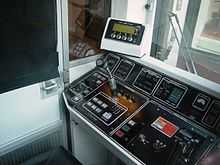
The fifth order consisted of 192 rail cars from a joint venture of Construcciones y Auxiliar de Ferrocarriles (CAF) of Spain and AAI Corporation of Hunt Valley, Maryland. These cars are numbered 5000–5191, with delivery in 2001.
Service introduction of these cars was heavily delayed due to software “glitches” which plagued delivery. At one point, WMATA looked to impose penalties against CAF for the service entry delays.
The contract consisted of CAF engineering and designing the cars and managing the project, while AAI performed assembly. These cars were the first Metrorail cars to originally feature alternating current traction inverters and motors. They were also the first to have LED destination signs on the exterior and LED “next stop” indication signs on the interiors. Along with these improvements, they were also the first to have intercar safety barriers (which have since been added to all other rolling stock) and railcar monitoring systems. The 5000-series cars premiered the red, white, and blue interior. This interior color scheme has since been used on the 2000/3000-series rehabilitation project and the 6000-series cars from Alstom.
Another feature is the return of cast steel trucks, which were previously only used on the Rohr cars.[26] This was done as a cost-saving measure, since fabricated trucks take additional time to manufacture due to the machining required.
The National Transportation Safety Board has begun an investigation about service life of these cars[27] due to recent non-revenue service derailments in Metrorail yards, and the January 7, 2007 derailment of a revenue train on the Green Line at the Mt Vernon Square station.
The planned midlife rehabilitation of the 5000-series cars is to take place in the late 2010s through the early 2020s. Design specifications are to be drafted in 2017, with the first cars rehabbed in 2022. This series of cars will be the third series of cars to have automated station announcements and the stainless steel paint scheme once they have been rehabilitated. The cars will be compatible with the 7000-series once the rehabilitation process is completed.[28] Metro announced in November 2013 that within two years, all 5000-series and 6000-series cars would feature new resilient flooring, replacing the existing carpeting.[29]
Cars 5066-5067 were wrecked on June 22, 2009.
6000-series
| Washington Metro 6000 series | |
|---|---|
|
Alstom 6024 at Branch Avenue | |
|
Interior of Alstom 6026 | |
| In service | 2006–present |
| Manufacturer | Alstom Transportation |
| Built at | Barcelona, Spain and Hornell, New York, USA |
| Constructed | 2005–2008 |
| Entered service | October 6, 2006 |
| Number built | 184 |
| Number in service | 184 |
| Formation | 4 cars per trainset |
| Fleet numbers | 6000–6183 |
| Capacity |
Seating: 64 Total: 175 |
| Operator | Washington Metropolitan Area Transit Authority |
| Specifications | |
| Car body construction | Extruded Aluminum |
| Train length | 300 feet (91.44 m) |
| Car length | 75 feet (22.86 m) |
| Width | 10 feet (3.05 m) |
| Height | 11.8 feet (3.60 m) |
| Doors | Sliding, 6 per car |
| Maximum speed | 75 mph (121 km/h) |
| Traction system | Four Alstom ONIX 2000 AC Traction Drives with IGBT Inverters[11] |
| Power output |
165 kilowatts (221 horsepower)[11] per motor 660 kilowatts (890 horsepower) per car |
| Electric system(s) | 750 DC third rail |
| Current collection method | Contact shoe |
| Track gauge | 4 ft 8 1⁄4 in (1,429 mm) |
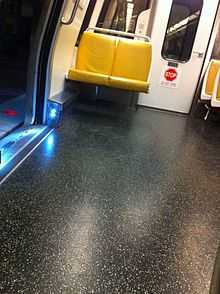
Subsequently, Metro ordered 184 rail cars from Alstom, the same company that rehabilitated the Breda 2000, and 3000 series cars. Delivery began in late 2005. These cars are being used on Metro trains; the first ones were deployed onto the Green Line. They look similar to the 5000-series cars built by CAF, but feature revised styling.
This is evident with bulkhead doors that have rounded windows compared to squared, and a revised operator window design which eliminates the top horizontal bar. These stylistic features are similar to what is found on the Rohr 1000-series cars. A major change that occurred for the first time since the Breda 2000-series cars is the reduction of seating. The 6000 series cars seat 64 instead of 68.
The interior has been completely redesigned to allow for additional standing room (mostly around the center doors) and easier access to all portions of the car. New to the 6000-series cars is the addition of two interior LED next stop indicators located at the center of the car, which brings the total to four interior displays per car (two facing each direction). Also new is an intercom located next to the center doors; previous railcars only have them at the front and back of each car.
Another new feature is that they are the first series of cars that will be manufactured with the flashing brake indicators on the far ends of each car. These are similar to what is used on the Rohr cars and the rehabilitated Bredas, and indicate when the train is in the final stages of stopping. Mechanically, the 6000 series cars features the same cast trucks as the CAF cars, and use the same propulsion systems and advanced cab signaling systems found in the Breda 2000/3000-series rehabilitation from Alstom.
The body shells of the 6000-series were built in Barcelona, Spain, with assembly completed in Hornell, New York.[30]
In 2007, Metro began testing new resilient flooring on four 6000-series cars (6104-105, 6142-6143).[31] They announced in November 2013 that within two years all 5000- and 6000-series cars would feature the new floors.[29]
On November 17, 2008, Metro completed the installation of new stainless steel-grab bars to all 184 6000-series cars.[32]
Metro is testing new fabric seating on cars 6026–6027. This type of seating will also be installed on cars 6014–6015.[33][34]
The first 6000-series railcar was placed into service on Friday, October 6, 2006, at 11:30 am on its inaugural trip from Greenbelt to Branch Avenue.[30]
7000-series
| Washington Metro 7000 series | |
|---|---|
|
7000-series railcar at Greenbelt station, January 6, 2014. | |
|
WMATA 7000-Series interior. | |
| In service | 2015-present |
| Manufacturer | Kawasaki Heavy Industries |
| Built at | Kawasaki Rail Car, Yonkers, New York, Lincoln, Nebraska, and Kobe, Japan[35] |
| Replaced |
|
| Constructed | 2012–2020 |
| Entered service | April 14, 2015 |
| Number under construction | 748 |
| Number built | 24 |
| Number in service | 8 |
| Formation | 4 cars per trainset |
| Fleet numbers | 7000–7747 |
| Capacity |
Seating: A-Car: 64 (transverse), 58 (longitudinal) B-Car: 68 (transverse), 64 (longitudinal)[36][37] Total: A-Car: 175 (Transverse seating), 184 (Longitudinal seating) B-Car: 184 (Transverse seating), 192 (Longitudinal seating) |
| Operator | Washington Metropolitan Area Transit Authority |
| Specifications | |
| Car body construction | Stainless Steel |
| Train length | 300 feet (91.44 m) |
| Car length | 75 feet (22.86 m) |
| Width | 10 feet (3.05 m) |
| Height | 11.8 feet (3.60 m) |
| Doors | Sliding, 6 per car |
| Maximum speed | 75 mph (121 km/h) |
| Weight | 80,000 lb (36,000 kg) |
| Traction system |
Toshiba SEA-430 AC with IGBT-VVVF Inverter[38][39] Motors were tested for the ability to function underwater[40] |
| Power output |
140 kilowatts (190 horsepower)[39] per motor 560 kilowatts (750 horsepower) per car |
| Acceleration | 2.8 mph/s (4.5 km/(h·s)) to 32 mph (51 km/h) |
| Deceleration |
2.2 mph/s (3.5 km/(h·s)) 3.2 mph/s (5.1 km/(h·s)) (emergency) |
| Electric system(s) | 750 DC third rail |
| Current collection method | Contact shoe |
| Coupling system | Fabricated steel truck[41] |
| Track gauge | 4 ft 8 1⁄4 in (1,429 mm) |
In April 2013, Metro moved forward with plans to order 528 railcars from Kawasaki, called the 7000-series, to replace older 1000-series cars, and to provide service for the Dulles Corridor Metrorail extension, otherwise known as the Silver Line.[42] Metro also exercised an option under the contract to purchase additional railcars to replace all of its older 4000-series cars.[42] In a February 8, 2007 press release, Metro stated that the new 7000-series cars would have a similar appearance to the 6000-Series cars manufactured by Alstom.[43] However, in a January 2008 press release, Metro indicated that the design for the 7000-series cars would have a completely different appearance from that of the current rail cars. The exterior would feature a stainless steel body rather than the aluminum of earlier designs.[44] Inside, seats would be taller and more ergonomically designed, carpeting would be replaced with a resilient floor covering,[44] the grab bars along the ceiling would contain spring-loaded handles,[45] and the cars would contain security cameras, as well as LCD displays to provide train information.[44]
There is also an option to install longitudinal seating instead of the traditional transverse seating found in all previous stock. Such an option would decrease seating capacity, but increase overall car capacity.
Car configuration would also be changed, requiring all 7000-series trains to run with four or eight cars. While still operating as married pairs, the cab in one car would be removed, essentially turning it into a B car (odd numbers), whereas cars with cabs would be A cars (even numbers). An eight-car configuration would look something like this:

The crosses between cars represent couplers, while the dashes represent link bars.[46]
The 7000-series cars will be so technologically advanced as to render them incompatible with the existing fleet. Presented with that issue, Metro's board members recognized the seriousness of the decision, but former Metro general manager John B. Catoe indicated that the board needed to decide "in months" on whether to go ahead with the rail car order, regardless of whether or not the Dulles extension was approved.[47]
The bidding process begun in December 2008. WMATA issued a notice to proceed to Kawasaki on July 27, 2010, after receiving funding from the Federal Transit Administration.[48]
Under the contract, Metro originally agreed to purchase 428 7000-series railcars, both to replace 1000-series cars as well as equip the new Silver Line. In April 2013, Metro elected to exercise an option in the contract to purchase an additional one hundred cars to replace its one hundred 4000-series cars, which it decided do not warrant being overhauled in light of chronic mechanical issues.[42] In September 2013, Metro announced it exercised another option under the contract to purchase an additional 220 7000-series railcars, bringing the total order to 748 railcars.[49] In total, the new 7000-series railcars will make up just more than fifty percent of Metro's rolling stock by 2018.[49] As of November 2013, it was being reported that the first 4 cars of the 7000-series would arrive before the end of 2013, and that they would then be tested for 30 weeks, which will allow Metro to troubleshoot any issues before full production begins.[50] According to documents introduced at a November Metro Board meeting, by October 2016, 300 of the 7000-series cars are expected to be in service and thus replace the 1000-series cars, and by September 2017, 100 of the 7000-series cars intended to replace the 4000-series are also expected to be in service, with additional cars arriving so that the entire order of 7000-series cars is in service by 2018.[51]
Procurement requirements and preliminary car specifications are available online.[52]
Metro unveiled the first 7000-series quad set at Greenbelt on January 6, 2014. The set is to commence acceptance testing for 8 months in order to finalize design specs and work out any problems, thereby allowing production and delivery of the remaining cars to commence during the summer of 2014.[53]
In September 2014, Metro reported that it was about one month away from finishing tests on the 7000-series test train, and it stated that it expected an eight-car train made up of 7000-series cars would start carrying paying passengers in early 2015. Metro indicated that by 2015 it would have 56 7000-series cars on hand.[3] At the same time, Metro revealed that during testing of the 7000-series test train, a software issue was discovered that it was still addressing, although Metro was confident that the hardware itself was solid.[3] Looking ahead, Metro indicated that "[t]he mass production schedule calls for 56 new cars to be delivered by June [2015]. Combined with the eight cars in the test group, that would give Metro 64 new cars, meaning eight [7000-series] trains of eight cars each would be in service next summer. After that, 300 more cars would arrive by February 2017, followed by an additional 100, for a total of 528 new cars at an overall cost of $1.46 billion . . . ." [3] Metro has warned its funding partners – VA, MD, and DC – that its option to purchase an addition 220 7000-series cars expires June 2015, and requires a funding commitment of $614 million for rolling stock, and $856 million for related infrastructure upgrades.[3][54] Metro announced in March 2015 that the system’s first 7000-series train will enter passenger service Tuesday, April 14, on the Blue Line, leaving Franconia-Springfield station around 7 in the morning.[55] At the same time, Metro's funding partners, VA, MD, and DC, agreed to fund the additional purchase of 220 7000-series cars, bringing the total purchase to 748 cars, all of which are expected to be in service before the end of 2020.[56]
8000-series
Following the replacement of the 1000-series and 4000-series cars with the new 7000-series between 2015 and 2017, Metro has proposed that all 366 2000-series and 3000-series cars be replaced by the 8000-series cars. The design phase is to commence in 2018, with the contract awarded the following year. Delivery of the cars is scheduled to begin in 2023.[57]
References
- ↑ Capital Needs Inventory (PDF), Washington Metropolitan Area Transit Authority, February 19, 2010, retrieved February 8, 2013
- ↑ "WMATA Summary - Level Rail Car Performance For Design And Simulation" (PDF). wmata.com. WMATA. 2013-10-13. Retrieved 2014-10-15.
- ↑ 3.0 3.1 3.2 3.3 3.4 "Metro says its new-generation rail cars are on track for passenger service in January". Washington Post. September 26, 2014. Retrieved September 27, 2014.
- ↑ Whitehorne, Wayne; Mark Greenwald. "Washington, D.C.". nycsubway.org. Retrieved January 21, 2008.
- ↑ "Tuesday Red Line service altered as a result of Monday collision" (Press release). Washington Metropolitan Area Transit Authority. June 23, 2009. Retrieved August 3, 2010.
- ↑ Mike DeBonis on June 22, 2009, at 9:01 pm. "Old Questions About Crashworthiness of Metro Cars – City Desk". Washington City Paper. Retrieved June 23, 2009.
- ↑ 7.0 7.1 "Metro testing new overhead handles inside Metrorail cars" (Press release). Washington Metropolitan Area Transit Authority. August 21, 2008. Retrieved August 3, 2010.
- ↑ Thomson, Robert (May 7, 2014). "D.C. streetcar opening still months away, but plans develop for next phase in Anacostia". WashPost. Retrieved May 8, 2014.
- ↑ "Customer Service and Operations Committee Board Information Item IV-A, 7000 Series Railcar Update" (PDF). wmata.com. WMATA. 2013-10-13. Retrieved 2014-09-20.
- ↑ 10.0 10.1 "WMATA Induction Motor". imgur. May 1995. Retrieved February 15, 2014.
- ↑ 11.0 11.1 11.2 11.3 "ALSTOM Transport – Metro in Washington, USA". Alstom. Archived from the original on March 25, 2006. Retrieved June 9, 2013.
- ↑ "Railroad Accident Report Collision of Washington Metropolitan Area Transit Authority Train T-111 with Standing Train at Shady Grove Passenger Station, Gaithersburg, Maryland January 6, 1996" (PDF). National Transportation Safety Board. October 29, 1996. Retrieved February 1, 2007.
- ↑ Laris, Michael (March 4, 2005). "Metro to Monitor Seating Patterns". The Washington Post. p. B02. Retrieved February 1, 2007.
- ↑ Lindeman, Todd (August 1, 2006). "More Room to Stand". The Washington Post. Retrieved February 1, 2007.
- ↑ "Metro Recommends First Phase of a Pilot Program to Enhance Railcar Capacity Aboard Metrorail Trains" (Press release). Washington Metropolitan Area Transit Authority. March 3, 2005. Retrieved February 1, 2007.
- ↑ "Railcar Capacity Analysis" (PDF). Washington Metropolitan Area Transit Authority. November 3, 2005. Retrieved February 1, 2007.
- ↑ "Washington HRV" (PDF). AnsaldoBreda. Retrieved February 15, 2014.
- ↑ "Metro removes 100 rail cars as a safety precaution". WTOP. July 4, 2010. Retrieved July 6, 2010.
- ↑ "Pulled Metrorail Cars Back in Service". NBC Washington. July 20, 2010. Retrieved August 3, 2010.
- ↑ "Performance Vehicle Planning" (PDF). Washington Metropolitan Area Transit Authority. October 10, 2008. p. 3. Retrieved January 21, 2009.
- ↑ "7000 Series Railcars Technical Specification" (PDF). WMATA. January 30, 2009. Retrieved February 15, 2014.
|chapter=ignored (help) - ↑ "Proposed FY2013 Operating and Capital Budget" (PDF). WMATA. January 12, 2012. Retrieved February 15, 2014.
- ↑ 23.0 23.1 Hedgpeth, Dana (April 8, 2013). "Metro to replace troubled rail cars with new ones". The Washington Post. Retrieved February 15, 2014.
- ↑ "CAF – Metro Unit Trains – Washington Metro". Construcciones y Auxiliar de Ferrocarriles. Archived from the original on September 14, 2012. Retrieved June 9, 2013.
- ↑ "Traction drives for metro, regional, intercity and high speed trains". Bombardier. Retrieved February 15, 2014.
- ↑ On Track With Added Value, Sharon Kruse, Engineered Casting Solutions
- ↑ "Derailment of Washington Metropolitan Area Transit Authority Train near the Mt. Vernon Square Station" (PDF). National Transportation Safety Board. Retrieved 26 January 2015.
- ↑ "FY2011 – FY2020 Capital Needs Inventory" (PDF). WMATA. October 21, 2008. p. 4. Retrieved February 15, 2014.
|chapter=ignored (help) - ↑ 29.0 29.1 "Metro to begin gradual replacement of carpet with resilient flooring" (Press release). WMATA. November 21, 2013. Retrieved February 15, 2014.
- ↑ 30.0 30.1 "Metro Unveils New 6000 Series Train On Green Line" (Press release). Washington Metropolitan Area Transit Authority. October 3, 2006. Retrieved January 12, 2008.
- ↑ "Metro tests new railcar designs" (Press release). Washington Metropolitan Area Transit Authority. December 4, 2007. Retrieved November 13, 2014.
- ↑ "Spring-loaded overhead handles installed on series 6000 Metrorail fleet" (Press release). Washington Metropolitan Area Transit Authority. November 17, 2008. Retrieved December 12, 2008.
- ↑ "Metro testing wool seats in rail cars" (Press release). Washington Metropolitan Area Transit Authority. December 9, 2008. Retrieved December 12, 2008.
- ↑ "Metro Tests New Wool Seat Covers". YouTube. December 8, 2008. Retrieved December 12, 2008.
- ↑ Briggs, Tyler; Thompson, Andy (March 25, 2010). "Alstom fails to win WMATA". Hornell Evening Tribune (Hornell, NY). Retrieved August 3, 2010.
- ↑ "7000 Series Railcar Procurement Drawings" (PDF). WMATA. January 2009. Retrieved February 15, 2014.
- ↑ "7000 Series Railcar Program Contract Award" (PDF). WMATA. March 25, 2010. Retrieved February 15, 2014.
- ↑ "US trains to be equipped with Toshiba traction". Railway Gazette. January 21, 2011. Archived from [tt_news=12692&cHash=22ed90aa66 the original] on January 26, 2011. Retrieved January 26, 2011.
- ↑ 39.0 39.1 "RAILROAD.NET • View topic - WMATA 7000 Series to have CCTV, Electronic Maps". railroad.net. Retrieved April 23, 2015.
- ↑ "RC7000 Vol 2 Tech Specs" dated January 30, 2009, paragraph 3.7.5.2 "AC Traction Motor", page TP 3–18
- ↑ "Washington Metropolitan Area Transit Authority 7000 Series Rapid Transit Railcar" (PDF). NBC Washington. Retrieved February 15, 2014.
- ↑ 42.0 42.1 42.2 Hedgpeth, Dana (April 8, 2013). "Metro to replace troubled rail cars with new ones". Washington Post. Retrieved April 8, 2013.
- ↑ "Metro Developing Plans For New Railcars" (Press release). Washington Metropolitan Area Transit Authority. February 8, 2007. Retrieved January 12, 2008.
- ↑ 44.0 44.1 44.2 "Metro considers new look for trains" (Press release). Washington Metropolitan Area Transit Authority. January 2008. Retrieved January 12, 2008.
- ↑ "Talks Underway For New Trains". The Washington Post. January 11, 2008. Retrieved January 12, 2008.
- ↑ "7000 Series Railcar RAC Overview" (PDF). Washington Metropolitan Area Transit Authority. July 2, 2008. Retrieved August 3, 2010.
- ↑ Sun, Lena (January 11, 2008). "Metro Eyes a Makeover". The Washington Post. p. B01. Retrieved January 12, 2008.
- ↑ "Metro to Kawasaki: Start building 7000 series rail cars" (Press release). Washington Metropolitan Area Transit Authority. July 27, 2010. Retrieved August 3, 2010.
- ↑ 49.0 49.1 Hedgpeth, Dana (September 12, 2013). "Metro buys more new rail cars". Washington Post. Retrieved February 15, 2014.
- ↑ Di Caro, Martin (November 1, 2013). "Metro To Begin Running New Railcars In Late 2014". WAMU 88.5. Retrieved February 15, 2014.
- ↑ "7000 Series Railcar Update" (PDF). WMATA. October 10, 2013. Retrieved February 15, 2014.
- ↑ "Solicitation RFP RC7000/RAM". WMATA. January 30, 2009. Retrieved February 24, 2009.
- ↑ Johnson, Matt (January 6, 2014). "See Metro's first 7000 series train as it arrives for testing". Greater Greater Washington. Retrieved February 15, 2014.
- ↑ "Metro's Dream Of All Eight-Car Trains May Be Derailed By Funding Challenges.<". WAMU. September 26, 2014. Retrieved September 27, 2014.
- ↑ http://wmata.com/about_metro/news/PressReleaseDetail.cfm?ReleaseID=5906
- ↑ "Metro’s long-awaited new subway cars set for April 14 debut". Washington Post. Retrieved April 23, 2015.
- ↑ "2000/3000 Series Rail Car Replacement" (PDF). WMATA. October 21, 2008. p. 2. Retrieved February 15, 2014.
Replace all 366 of the 2000 and the 3000 Series rail cars with new 8000 Series rail cars.
External links
| Wikimedia Commons has media related to Washington Metro rolling stock. |
- world.nycsubway.org: Rolling stock interiors
- Washington Metropolitan Area Transit Authority Fleet Management plans (revised May, 2007)
- Live From the Third Rail: WMATA 6000 Series Railcar Preview archived from the original; WMATA 6000 Series Rail Cars Reviewed archived from the original
- 2011–2020 Capital Needs Inventory
| ||||||||||||||||||
.jpg)
